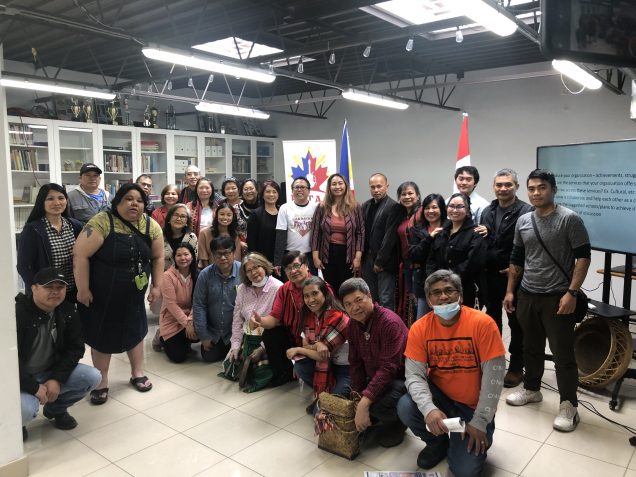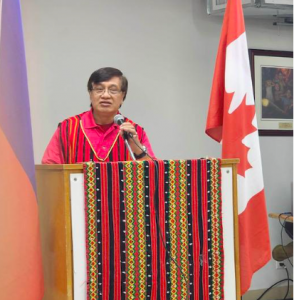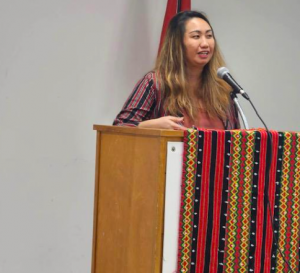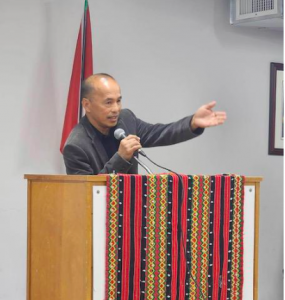Peoples’ Cordillera Day
Peoples’ Cordillera Day

Members and supporters of Cordillera groups pose for photo after the event at FCT.
By Lui Queaño
It was more about laying a solid groundwork for better community relations, and everyone collaborated to put on a successful Cordillera day celebration at the Filipino Centre Toronto on Saturday, April 25 with the theme “Pagsasabatan, Pantatabalan ken Pakaistoryaan” (Community gathering, sharing stories and the realities of the times).
This event was made possible by the Anti-Racism Anti-Hate (ARAH) project, which was sponsored by the Philippine Advancement Through Arts and Culture (PATAC) organisation.
In addition to Anakbayan Scarborough and Malaya Canada in Toronto, community organisations Migrante Ontario and the Canada Philippines Solidarity Organisation (CPSO) also participated in the event.

Alfredo Tomas, the president of the Ifugao-Kalinga
The story by Ceres P. Doyo published in a Philippine newspaper in the 1970s, “Was Macliing killed because he damned the dam?” was adapted into a short video about Macliing Dulag and shown to the audience.
Doyo penned the story that prompted the armed forces to investigate her in the 1970s. Everyone in the room had to be completely silent as the short video played. Professor Nonilon Queano composed and performed the music heard in the background during the segment on Macliing Dulag. This added to the solemnity and poignancy of the occasion.
PATAC President Ben Corpuz became emotional when he recalled how together with his late wife, Paulina Corpuz, who was an Ibanag native of Cagayan and herself an indigenous person, had brought a piece of stone that reminds him of home to Canada. Ben Corpuz was asked why he brought a stone with him when he was questioned by immigration officials. In response, Ben Corpuz stated that the stone was part of the indigenous land that he and his wife originally came from.
Alfredo Tomas, president of the Ifugao-Kalinga Association of Canada, put it best when he said, “When we come together as one, we have more power, and we could accomplish more.” During his brief but rousing speech at the Cordillera event, Tomas drove home the point that this is an issue of critical importance. Tomas explains that “pagsasabatan” (storytelling) is an important part of community gatherings because it helps people figure out how they can help each other.
Tomas left the Philippines in the 1990s and settled in Canada at a time when there was no local Igorot community for him to join. He was able to connect with others through his heritage, and the Ifugao-Kalinga group that emerged as a result eventually became a mainstay at the numerous festivals and celebrations held in Toronto. The Igorot people were able to find unity and reconnect with their cultural roots, which has attracted the attention of other indigenous communities because of the progress that they have made in these areas.

Gretchen Mangahas, president of
Kabenguetan
Gretchen Mangahas described how, through her rich cultural practise of dance, she eventually discovered both her “kakailian” (community) and her roots. Mangahas is now the president of her own 300-member organisation known as “Kabenguetan,” and she has used the government funding she was able to secure to educate people from other backgrounds about the culture and way of life of the Igorot. Mangahas wished she could do more to provide her community with the cultural, social, and political environments required for her group to be represented in the Filipino community in Toronto.
Even Johnson Aben, president of BIBAK, which is an organization that represents the Igorots in the provinces of Benguet, Ifugao, Bontoc, Apayao, and Kalinga, was on the lookout for his people when he first arrived in Canada in the 1990s. He was in Toronto at that time. Aben was looking for his people from the Philippines. After putting in a lot of effort, Aben was finally able to feel like he belonged in the community when he started doing gangsa dances at local events. He has since played a crucial role in the ongoing efforts of Igorot communities to preserve their culture through the presentation of traditional gangsa dances.
Shirley Balungay, the president of the Bontoc Ato community, was quick to acknowledge the significance of the event for her community and how she believed that future collaborations could help raise awareness about the significance of community support. Balungay mentioned that her organization helps fundraise for scholarship of poor but deserving Igorots in the Philippines. This has been the advocacy of Balungay’s group ever since it was established.

Johnson Aben, President BIBAK
Photos: Lui Qeaño
The event lasted for a total of five hours, during which time participants were exposed to a variety of activities, including messages of solidarity, speeches, cultural numbers, video presentations, and even group workhops, in addition to hearing a Cordillera national situationer delivered by Dr. Chandu Claver.
Dr. Chandu Claver, a member of the Cordillera Peoples’ Alliance (CPA), spoke about the current situation in the region, detailing the bombing of communities, rampant human rights violations, red-tagging of indigenous leaders, illegal mining activities, and the pervasiveness of militarization. The presentation goes on to frame Macliing Dulag’s leadership of his tribe’s opposition to the construction of Chico dam as the impetus for the international solidarity of indigenous peoples of the Cordillera in the fight for their land, life, and honour.
In his concluding remarks, Migrante organiser Jay Jay Carpio emphasised the significance of establishing a Migrante chapter in Scarborough due to the growing number of migrant workers in the region, including indigenous peoples, international students, temporary foreign workers, and undocumented Filipino migrant workers. Carpio invited the participants to participate in the official launch of Migrante Scarborough in August of this year..
After a number of years in which Cordillera Day was not celebrated in Toronto, it seemed as if the gangsa sound had been replayed, inspiring the indigenous communities that had gathered there to rise to the occasion and, in a joyous celebratory mood, once again declare their bravery and, in a voice that had been converted, call “Sumkad dagiti para iti daga, biag ken dayaw!” (Rise up and fight for both your life and your honour!)
Gatherings of community groups, including Igorot groups, have always been about more than just catching up and swapping narratives and tales; they’ve also been opportunities to plot out joint projects that will help fulfil members’ aspirations to feel like they belong somewhere. There was an immediate sense of community, a solid foundation upon which to build a lasting relationship.
*(Community gathering, sharing of stories and the realities of the times)
Comments (0)